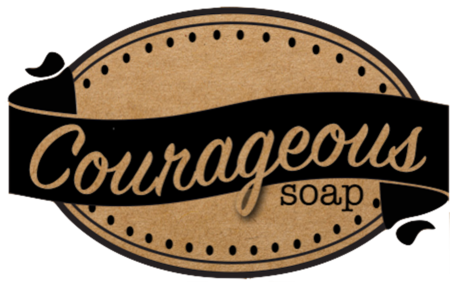
When last we journeyed into natural color (The Thing about Natural Color, Part 1), I had reported my experience of the pros and cons of natural (plant-based) vs. synthetic/processed (micas, oxides and other mineral-based) color in soap making.
Quick recap: My ideal is a mix of natural and synthetic color. Plant-based color has the advantage of being "natural", which many customers claim to prefer (though that hasn't always born out as I've observed the bars they gravitate to at markets  ). Synthetic color (micas/oxides) can "pop" more and they don't tend to fade. Clays, like other mineral-based color, are processed to remove heavy metals - some makers consider them natural, others don't.
). Synthetic color (micas/oxides) can "pop" more and they don't tend to fade. Clays, like other mineral-based color, are processed to remove heavy metals - some makers consider them natural, others don't.
 This coffee soap, for example, is colored with a mix of activated charcoal (black, plant-based), Titanium Dioxide (white, mineral-based), instant coffee granules (brown, plant-based), and uncolored soap that gets a yellow tint from the Expresso fragrance oil (synthetic scent).
This coffee soap, for example, is colored with a mix of activated charcoal (black, plant-based), Titanium Dioxide (white, mineral-based), instant coffee granules (brown, plant-based), and uncolored soap that gets a yellow tint from the Expresso fragrance oil (synthetic scent).The combination of the activated charcoal and titanium white provide "pop", the coffee provides a warm medium tone with visual texture - all contrasting with the fragrance oil-tinted, uncolored soap.
I'm currently engaged in a plant-based, soap color challenge where mineral-based color isn't permitted. I'll have to work around the lack of titanium dioxide by using extremely light/white base oils, be mindful of scents that might add color, and consider the concentrations of my plant-infused oil bases to provide color and contrast. The parameters of the challenge require that I create a third color by combining two different base colors ("uncolored"/white is considered a color).
 One of my early attempts is shown here: I used mostly infused oils @ 19% of my base oil recipe: madder root (mauve), paprika (rich orange), safflower (pale yellow) and a mix of madder root/safflower for a pale, rosy-beige shade. I added a bit of the madder root and safflower powder-sludge to boost the color without adding too many speckles. Because paprika powder can be scratchy, I only used the infused oil. Activated charcoal was added at the powder stage - it's finely ground enough to provide the black color without specks. The white areas are uncolored soap.
One of my early attempts is shown here: I used mostly infused oils @ 19% of my base oil recipe: madder root (mauve), paprika (rich orange), safflower (pale yellow) and a mix of madder root/safflower for a pale, rosy-beige shade. I added a bit of the madder root and safflower powder-sludge to boost the color without adding too many speckles. Because paprika powder can be scratchy, I only used the infused oil. Activated charcoal was added at the powder stage - it's finely ground enough to provide the black color without specks. The white areas are uncolored soap.
The scent combo of orange 10x, anise, and bergamot was tricky. Orange 10x tints soap orange, so I combined it with half the bergamot (very pale yellow) and used it only in the madder root, paprika, and charcoal batches. The anise (clear) and other half of the bergamot went into the safflower, madder/safflower, and uncolored soap. Is this a lot to keep track of? Yes. That's one of the trade-offs of fancy schmancy, naturally-colored soap.
I'm quite happy with how these bars came out and now planning other color combos to try.
Stay tuned - more to come.
(Have you tried natural color in your soap? Can you relate to this fiddy journey? Any tips or tricks you want to add? Please lmk in the comments below!)
 One of my early attempts is shown here: I used mostly infused oils @ 19% of my base oil recipe: madder root (mauve), paprika (rich orange), safflower (pale yellow) and a mix of madder root/safflower for a pale, rosy-beige shade. I added a bit of the madder root and safflower powder-sludge to boost the color without adding too many speckles. Because paprika powder can be scratchy, I only used the infused oil. Activated charcoal was added at the powder stage - it's finely ground enough to provide the black color without specks. The white areas are uncolored soap.
One of my early attempts is shown here: I used mostly infused oils @ 19% of my base oil recipe: madder root (mauve), paprika (rich orange), safflower (pale yellow) and a mix of madder root/safflower for a pale, rosy-beige shade. I added a bit of the madder root and safflower powder-sludge to boost the color without adding too many speckles. Because paprika powder can be scratchy, I only used the infused oil. Activated charcoal was added at the powder stage - it's finely ground enough to provide the black color without specks. The white areas are uncolored soap.The scent combo of orange 10x, anise, and bergamot was tricky. Orange 10x tints soap orange, so I combined it with half the bergamot (very pale yellow) and used it only in the madder root, paprika, and charcoal batches. The anise (clear) and other half of the bergamot went into the safflower, madder/safflower, and uncolored soap. Is this a lot to keep track of? Yes. That's one of the trade-offs of fancy schmancy, naturally-colored soap.
I'm quite happy with how these bars came out and now planning other color combos to try.
Stay tuned - more to come.
(Have you tried natural color in your soap? Can you relate to this fiddy journey? Any tips or tricks you want to add? Please lmk in the comments below!)

Leave a comment